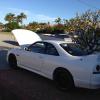Does Altering Your Ebc Have Any Affect On Your Current Tune?
Announcements
-
Similar Content
-
Latest Posts
-
I have a 32 GTR and recently had the standard 5 speed rebuilt with R33 s2 syncros and have this exact same problem! Gearbox shifts fine when not under load but doesn’t matter what gear I am in and if I try and change gears under power then it always misses the next gear and the pedal goes to the floor… I have a cube short shifter on it as well and have the recommended redline MT90 and Nulon smooth shift so not sure what’s going on..?
-
Does anyone use thread tape on the threads of this bolt or just bolt it back in?
-
By hardsteppa · Posted
So doing a bit of freshen-up work on the car at the moment, and thought about the throttle cable being now 30 years old. Given it's 'pretty important' was thinking about changing it but it's a discontinued part, and $500 from some sellers, whereas the R34 cable is only $100. The throttle is in almost exactly the same spot; I'm thinking, should fit or be close enough to space out or make a new bracket to fit...? Thoughts...? -
By hardsteppa · Posted
I previously used a Nismo mount, polyfilled the gaps. No issues with it. Had put a GKTech one in 3-5 years back ( I now do less than 2000 k's a year in this car) and when under there this weekend, found it has crumbled apart and the goo/crumble stinks like nothing else, smells horrendous. Will be putting the Nismo one back in for the time being but open to suggestions. Not keen on any more GK Tech products at the moment, also found one of their engine mounts has broken a stud, just snapped when I went to undo it. Also not that old, minimal k's.
-







Recommended Posts
Create an account or sign in to comment
You need to be a member in order to leave a comment
Create an account
Sign up for a new account in our community. It's easy!
Register a new accountSign in
Already have an account? Sign in here.
Sign In Now